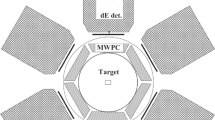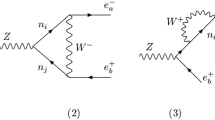Abstract
The missing piece of the puzzle: the discovery of the Higgs boson On July 4, 2012 the CMS and ATLAS collaborations at the large hadron collider jointly announced the discovery of a new elementary particle, which resembled the Higgs boson, the last remaining undiscovered piece of the standard model of elementary particles. Both groups claimed to have observed a five-standard-deviation (five sigmas) effect above background, the gold standard for discovery in high-energy physics. In this essay I will briefly discuss the how the CMS collaboration performed the experiment and analyzed the data. I will also show the experimental results.














Similar content being viewed by others
Notes
Some might argue for the recent BICEP2 result (Ade et al. 2014) that supports inflationary cosmology and the existence of gravity waves as a better choice, although questions have recently been raised concerning the analysis of that experiment.
In this essay I will discuss only the initial discovery papers. These used the 7 TeV data and 5 \(\hbox {fb}^{-1}\) of 8 TeV data. Later results used a total of 20 \(\hbox {fb}^{-1}\) of 8 TeV data. This provided more convincing evidence for the existence of the boson, all of which is consistent with the SM Higgs boson.
I chose the CMS experiment because my colleagues in high-energy physics at the University of Colorado are part of that collaboration. I know more about the experiment and I can also ask questions about the experiment more easily. The published CMS paper contains substantial technical detail. I will attempt to simplify those discussions.
All mentions of “collaboration” will, unless otherwise specified refer to the CMS collaboration.
Because the mass of the Higgs boson is less than the mass of either two Z bosons or two W bosons, one of these bosons must be off the mass shell.
For a more detailed discussion see Franklin (2002).
This was a measure of the local signal significance, obtained by looking at the data only in the signal region. A global significance uses the entire energy range.
For a discussion of this issue see Franklin (2013, Prologue). A discovery claim is synonymous with the words “Observation of” in the title of the paper. Any signal less than 5 \(\upsigma \) requires a title of “Evidence for,” “Measurement of,” or some other phrase.
A trigger system includes counters and other detectors along with computer programs for making a fast decision on whether to record the detector data for each event.
Luminosity is a measure of the intensities of the colliding beams that relates the probability of an interaction to the observed event rate. For a detailed discussion see http://cas.web.cern.ch/cas/Bulgaria-2010/Talks-web/Herr-1-web.pdf.
Each event is quite complex with as many as one hundred or more tracks.
This processor farm consists of approximately 1000 commercial processors.
My colleagues, who are members of the CMS collaboration, inform me that such changes do occur.
Data from events that pass the Level-1 trigger are stored in a buffer. The HLT is then implemented so that a decision can be made as to whether the data should be permanently stored. This must, of course, be done quickly.
This extended calibration procedure was not mentioned in the Higgs discovery paper, but it was known to the community through published papers and talks at conferences and elsewhere.
This had been done only for the 7 TeV data.
An example might help. Suppose you have 100 boxes and one of them contains a prize. If you pick a single box the probability of winning the prize is 1/100. If you examine 30 boxes your chance of winning the prize is approximately 30/100. This is the look-elsewhere effect.
\(\upsigma \) here does not mean either cross section or standard deviation. The experimenters noted, “The symbol \(\upsigma /\upsigma _\mathrm{SM}\) denotes the production cross section times the relevant branching fractions, relative to the SM expectation (Chatrchyan et al. 2012, p. 42)”.
The group applied two different selection criteria to enhance the sensitivity of their search.
A jet is a narrow cone of hadrons (strongly interacting particles) and other particles produced by a combination of quarks and gluons, the constituents of elementary particles. Because quarks are confined within particles they cannot exist in free form. Therefore they fragment into hadrons before they can be directly detected, becoming jets.
These categories involved different selection criteria for the Higgs signal and the background.
Table 2 showed the expected number of events for different selection criteria for the Higgs signal and the background.
The uncertainties in other decay channels were discussed in a separate paper.
Before including the effect of the uncertainties the significance had been 6.0 \(\upsigma \).
The title of the CMS paper was “Observation of a new boson at a mass of 125 GeV with the CMS experiment at the LHC” and that of the ATLAS was, “Observation of a New Particle in the Search for the SM Higgs Boson with the ATLAS Detector at the LHC”.
References
Aad, G., Abajyan, T., et al. (2012). Observation of a new particle in the search for the standard model higgs boson with the ATLAS detector at the LHC. Physics Letters B, 716, 1–29.
Adam, W., Bergauer, T., et al. (2006). The CMS high level trigger. European Physics Journal C, 46, 605–667.
Ade, P. A. R., Aikin, R. W., et al. (2014). “BICEP2 I: Detection of B-mode Polarization at Degree Angular Scales”. arXiv:1403.3985v2[astro-ph.CO]: 1–19.
Chatrchyan, S., Khachatryan, V., et al. (2012). Observation of a new boson at a mass of 125 GeV with the CMS experiment at the LHC. Physics Letters B, 716, 30–61.
Franklin, A. (2002). Selectivity and Discord. Pittsburgh: University of Pittsburgh Press.
Franklin, A. (2013). Shifting Standards: Experiments in Particle Physics in the Twentieth Century. Pittsburgh: University of Pittsburgh Press.
Karaca, K. (2011). Progress Report-2-Project: The Epistemology of the LHC. Wuppertal, DE: A. Franklin.
Author information
Authors and Affiliations
Corresponding author
Rights and permissions
About this article
Cite this article
Franklin, A. The missing piece of the puzzle: the discovery of the Higgs boson. Synthese 194, 259–274 (2017). https://doi.org/10.1007/s11229-014-0550-y
Received:
Accepted:
Published:
Issue Date:
DOI: https://doi.org/10.1007/s11229-014-0550-y




